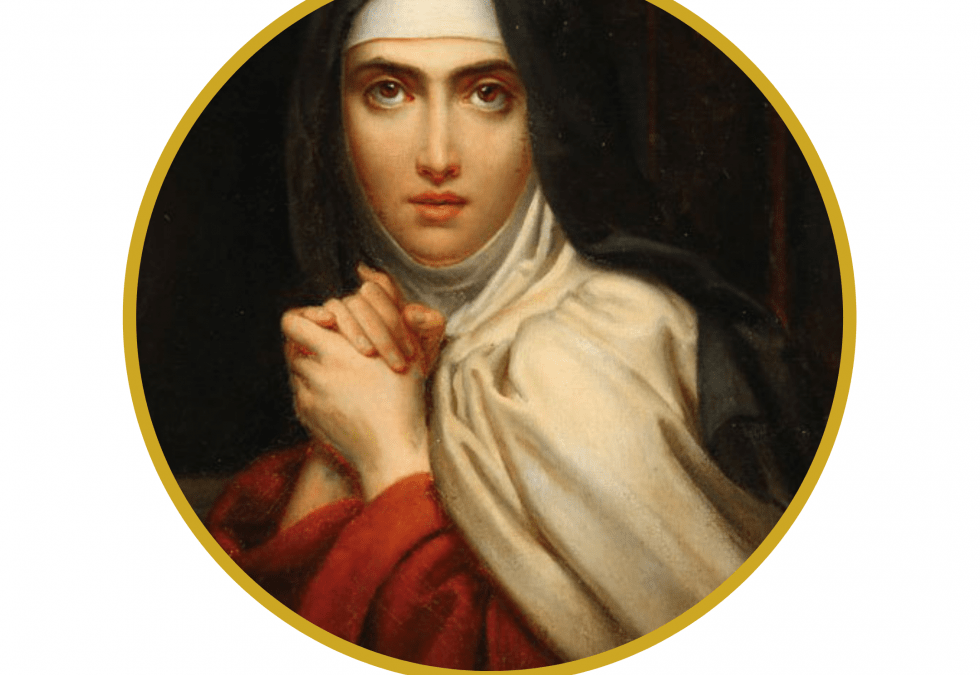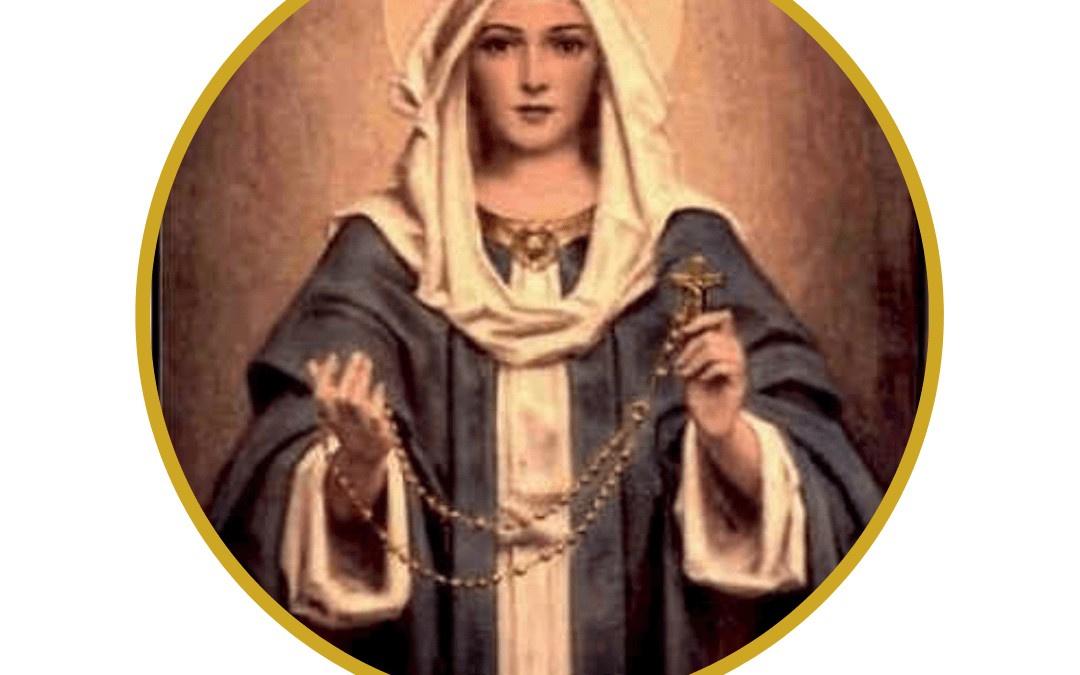
15 October: Feast of Saint Teresa of Jesus
15 October: Feast of Saint Teresa of Jesus. Also known as St. Teresa of Avila, she was born in the Spanish city of Avila in 1515. Her father was an ardent Catholic, with a collection of spiritual books of the type his daughter would later compose herself. As a child, Teresa felt captivated by the vision of God granted to the saints in heaven. She and her brother once ran away from home for the sake of dying as martyrs in a Muslim country, though a relative found them and promptly sent them back home. When Teresa was 14, her mother died, causing profound grief and prompting Teresa to embrace the Virgin Mary as her spiritual mother. After this, she struggled with a loss of her childhood zeal for God. Her father sent her to be educated in a convent of Augustinian nuns. Illness forced her to leave the convent. But the influence of a devout uncle, along with reading St. Jerome’s writings, convinced Teresa to then join the Carmelite Order at age 20. She again became seriously ill. She had severe pain and physical paralysis for two years, and afterwards remained in a painful debilitated state. For the next 20 years, she was an obedient Carmelite but struggled with physical pain and spiritual dryness. When she was nearly 40, Teresa was dramatically called to contemplative prayer. She experienced profound changes in her soul and received visions from God. During prayer, Teresa heard God speak and often became totally enraptured and even levitated. These graces reached a climax when her heart received a “transverberation” (piercing) – a mystical grace where a saint’s heart is pierced with a “dart of love” by an angel. Teresa played a significant role in the renewal of the Church that followed the Council of Trent. She proposed a return of the Carmelites to their original rule of life, a simple and austere form of monasticism (founded on silence and solitude) believed to date back to the prophet Elijah. Together with Saint John of the Cross, she founded the Order of Discalced Carmelites – “discalced,” meaning barefoot. She went on to found 30 monasteries. In 1582, Teresa’s health failed her for the last time and she died on October 15th. She was canonized in 1622. In 1970, Pope St. Paul VI proclaimed St. Teresa the first woman Doctor of the Church. She is called doctrix mystica, doctor of mystical theology. {Nine months after Teresa died, her body was exhumed and found incorrupt. Later, her heart was removed, enclosed in a crystal vessel and placed in a silver reliquary. While this was being done they beheld a glorious sight: a visible wound from the angel’s dart! It can still be seen today at the Carmelite Monastery of Alba de Tormes in Spain. Miraculously, her heart has kept its color and three sharp thorns in the heart are still visible today.}
“Let nothing affright thee, Nothing dismay thee. All is passing, God ever remains. Patience obtains all. Whoever possesses God Cannot lack anything. God alone suffices.” –St. Teresa of Avila
Ideas for celebrating this feast day at home:
- FORMED has several books and videos about St. Teresa of Avila: click here.
- Feast day food: make a Spanish recipe, such as Paella, Gazpacho, or Spanish omelet. Also, make Teresa’s Bread and St. Teresa’s Egg Yolks (Called yemas, candied egg yolks are a popular dessert in Avila.)
- Bake Carmel Apple Cookies: feasts of Teresa of Avila and Therese of Lisieux, Carmelite nuns, are in October (apple season). This cookie combines the seasonal harvest with caramel — a play on words with “Carmel”
- Read the Autobiography of St. Teresa. Her other books Interior Castleand Way of Perfection are more difficult and lofty to read, but are spiritual classics.
- For kids – Learn about “Who is St. Teresa of Avila?” using this activity from Loyola Press
- Read what Pope Benedict XVI writes about Saint Teresa of Avila, here.
- Study S Teresa’s Teaching on the Grades of Prayer and Read Demons According to St. Teresa and St. John of the Cross by Fr. Antonio Moreno.
- Pray the Litany of Saint Teresa of Jesus, The Glory of Spain

10 October 2021 Bulletin
Click to read this week’s bulletin: 10 October 2021

7 October: Feast of Our Lady of the Rosary
7 October: Feast of Our Lady of the Rosary. Known for centuries as the Feast of “Our Lady of Victory,” this day takes place in honor of a naval victory which secured European Christendom against Turkish invasion in 1571. Pope St. Pius V attributed the victory at Lepanto — one of the most decisive in all of naval history according to historians — to the intercession of the Blessed Virgin Mary through a campaign to pray the Rosary. The Muslim Ottoman Empire had been expanding into Europe for 900 years. By 1453, they took over Christian lands in the Byzantine Empire, and continued into the Mediterranean, threatening Rome. Pope Pius V called for prayer and action. He pleaded with every man, woman, and child to pray the Rosary. He also put together the Holy League: a coalition of Catholic powers which included Genoa, Spain, and the Papal States. Its fleets sailed to confront the Turks near the west coast of Greece on October 7, 1571. They were vastly outnumbered. The Pope, Christians throughout Europe, and crew members armed themselves with the Rosary in preparation for battle. Mass was said on all 200 ships. People prayed from dawn to dusk. Christians in Europe, encouraged by the Pope, gathered to invoke the Virgin Mary against the daunting Turkish forces. They kept churches open day and night so everyone could pray and ask for Mary’s help. The wind was against the Christians and the heavy iron rams (which ordinarily were used to ram and sink enemies) had been removed because over 18,000 Christian slaves were oarsmen in the galleys. The Holy Alliance chose to handicap themselves rather than sacrifice the slaves. As the battle commenced, everyone prayed. Some accounts say that Pope Pius V was granted a miraculous vision of the Holy League’s stunning victory at 4pm that day. The Pope understood the significance of the day’s events, when he was eventually informed that all but 13 of the nearly 300 Turkish ships had been captured or sunk. The victory was decisive and crushing. It marked a turning point in the history of Christianity and of Europe. Pope Pius V dedicated the day as one of thanksgiving to Our Lady of Victory. Pope Gregory XIII later changed the name to the Feast of Our Lady of the Rosary.
“It has always been the habit of Catholics in danger and in troublous times to fly for refuge to Mary. This devotion, so great and so confident, to the august Queen of Heaven, has never shone forth with such brilliancy as when the militant Church of God has seemed to be endangered by the violence of heresy … or by an intolerable moral corruption, or by the attacks of powerful enemies.” – Pope Leo XIII
Ideas for celebrating this feast day at home:
- Our Lady at Fatima said: “I am the Lady of the Rosary. Continue always to pray the Rosary every day.” Today, Pray the Rosary with your family. Keep it up throughout October, the month dedicated to the Rosary.
- Learn and memorize prayers to Mary, such as: Litany of Loreto, the Memorare, and Hail Holy Queen.
- Pope Leo XIII was devoted to Our Lady of the Rosary, producing 11 encyclicals on the subject of this feast and its importance. Read his and other papal encyclicals on the rosary at this link.
- Craft idea: Learn to make a rosary at home! Ideas here and here and here.
- Feast day treat: Since the origin of this feast came from the Christian fleet defeating the Turks at sea, why not make a cake in the shape of a ship? Look at this Pirate Ship Cake for ideas. Decorate your table in blue, in honor of the Blessed Mother. Another idea: Make a cupcake rosary (a “rosary” made out of cupcakes, mini cupcakes, or cookies). Idea here.
- Pius V was a holy Dominican, who wore his scratchy habit underneath his papal robes, and walked around Rome barefoot. He ate just to sustain himself, and fasted often. Follow his example and fast and pray the Rosary for the conversion of sinners and end to religious persecution around the world.
Recent Comments